Decoration of CuO NWs Gas Sensor with ZnO NPs for Improving NO2 Sensing Characteristics
Abstract
1. Introduction
2. Materials and Methods
2.1. Growth of the CuO NWs
2.2. ZnO NPs Decoration on the CuO NWs Gas Sensor
3. Results and Discussion
3.1. Material Analysis
3.1.1. Field-Emission Scanning Electron Microscopy (FE-SEM) and Energy-Dispersive X-ray Spectroscopy (EDS) Analyses
3.1.2. X-ray Diffraction (XRD) Analysis
3.2. Effect of the CuO/ZnO Heterojunction on Gas Sensing
3.3. Gas Sensing Performance
4. Conclusions
Author Contributions
Funding
Institutional Review Board Statement
Informed Consent Statement
Data Availability Statement
Conflicts of Interest
References
- Yamazoe, N. Toward innovations of gas sensor technology. Sens. Actuators B Chem. 2005, 108, 2–14. [Google Scholar] [CrossRef]
- Kaushik, A.; Kumar, R.; Jayant, R.D.; Nair, M. Nanostructures gas sensors for health care: An Overview. J. Pers. Nanomed. 2015, 1, 10–23. [Google Scholar] [PubMed]
- Miller, D.R.; Akbar, S.A.; Morris, P.A. Nanoscale metal oxide-based heterojunctions for gas sensing: A review. Sens. Actuators B Chem. 2014, 204, 250–272. [Google Scholar] [CrossRef]
- Dey, A. Semiconductor metal oxide gas sensors: A review. Sens. Actuators B Chem. 2018, 229, 206–217. [Google Scholar] [CrossRef]
- Barsan, N.; Simon, C.; Heine, T.; Pokhrel, S.; Weimar, U. Modeling of sensing and transduction for p-type semiconducting metal oxide based gas sensors. J. Electroceram. 2010, 25, 11–19. [Google Scholar] [CrossRef]
- Bejaoui, A.; Guerin, J.; Aguir, K. Modeling of a p-type resistive gas sensor in the presence of a reducing gas. Sens. Actuators B Chem. 2013, 181, 340–347. [Google Scholar] [CrossRef]
- Kim, H.J.; Lee, J.H. Highly sensitive and selective gas sensors using p-type oxide semiconductors: Overview. Sens. Actuators B Chem. 2014, 192, 607–627. [Google Scholar] [CrossRef]
- Li, Y.; Wlodarski, W.; Galatsis, K.; Moslih, S.h.; Cole, J.; Russo, S.; Rockelmann, N. Gas sensing properties of p-type semiconducting Cr-doped TiO2 thin films. Sens. Actuators B Chem. 2002, 83, 160–163. [Google Scholar] [CrossRef]
- Zhao, S.; Shen, Y.; Zhou, P.; Zhang, J.; Zhang, W.; Chen, X.; Wei, D.; Fang, P.; Shen, Y. Highly selective NO2 sensor based on p-type nanocrystalline NiO thin film prepared by sol-gel dip coating. Ceram. Int. 2018, 44, 753–759. [Google Scholar] [CrossRef]
- Wisitsoraat, A.; Tuantranont, A.; Comini, E.; Sberveglieri, G.; Wlodarski, W. Characterization of n-type and p-type semiconductor gas sensors based on NiOx doped TiO2 thin films. Thin Solid Films 2009, 517, 2775–2780. [Google Scholar] [CrossRef]
- Li, D.; Hu, J.; Wu, R.; Lu, J.G. Conductometric chemical sensor based on individual CuO nanowires. Nanotechnology 2010, 21, 485502. [Google Scholar] [CrossRef] [PubMed]
- Eranna, G.; Joshi, B.C.; Runthala, D.P.; Gupta, R.P. Oxide Materials for Development of Integrated Gas Sensors-A Comprehensive Review. Crit. Rev. Solid State Mater. Sci. 2004, 29, 111–188. [Google Scholar] [CrossRef]
- Arshak, K.; Moore, E.; Lyons, G.M.; Harris, J.; Clifford, S. A review of gas sensors employed in electronic nose applications. Sens. Rev. 2004, 24 No.2, 181–198. [Google Scholar] [CrossRef]
- Wu, D.; Zhang, Q. LSDA+U study of cupric oxide: Electronic structure and native point defects. Phys. Rev. B 2006, 73, 235206. [Google Scholar] [CrossRef]
- Kidowaki, H.; Oku, T.; Akiyama, T.; Suzuki, A.; Jeyadevan, B.; Cuya, J. Fabrication and Characterization of CuO-based Solar Cells. J. Mater. Sci. Res. 2012, 1, 138–143. [Google Scholar] [CrossRef]
- Barzegar, M.H.; Ghaedi, M.; Avargani, V.M.; Sabzehmeidani, M.M.; Sadeghfar, F.; Jannesar, R. Electrochemical synthesis and efficient photocatalytic degradation of azo dye alizarin yellow R by Cu/CuO nanorods under visible LED light irradiation using experimental design methodology. Polyhedron 2019, 158, 506–514. [Google Scholar] [CrossRef]
- Jin, Z.; Zhang, X.; Li, Y.; Li, S.; Lu, G. 5.1% Apparent quantum efficiency for stable hydrogen generation over eosin-sensitized CuO/TiO2 photocatalyst under visible light irradiation. Catal. Commun. 2007, 8, 1267–1273. [Google Scholar] [CrossRef]
- Hoa, N.D.; Quy, N.V.; Tuan, M.A.; Hieu, N.V. Facile synthesis of p-type semiconducting cupric oxide nanowires and their gas-sensing properties. Phys. E 2009, 42, 146–149. [Google Scholar] [CrossRef]
- Lupan, O.; Postica, V.; Cretu, V.; Wolff, N.; Duppel, V.; Kienle, L.; Adelung, R. Single and networked CuO nanowires for highly sensitive p-type semiconductor gas sensor applications. Phys. Status Solidi RRL 2016, 10, 260–266. [Google Scholar] [CrossRef]
- Hansen, B.J.; Kouklin, N.; Lu, G.; Lin, I.; Chen, J.; Zhang, X. Transport, Analyte Detection, and Opto-Electronic Response of p-Type CuO Nanowires. J. Phys. Chem. C 2010, 114, 2440–2447. [Google Scholar] [CrossRef]
- Kim, K.M.; Jeong, H.M.; Kim, H.R.; Choi, K.I.; Kim, H.J.; Lee, J.H. Selective Detection of NO2 Using Cr-doped CuO Nanorods. Sensors 2012, 12, 8013–8025. [Google Scholar] [CrossRef]
- Na, C.W.; Woo, H.S.; Lee, J.H. Design of highly sensitive volatile organic compound sensors by controlling NiO loading on ZnO nanowire networks. RSC Adv. 2012, 2, 414–417. [Google Scholar] [CrossRef]
- Choi, S.W.; Park, J.Y.; Kim, S.S. Synthesis of SnO2-ZnO core-shell nanofibers via a novel two-step process and their gas sensing properties. Nanotechnology 2009, 20, 465603. [Google Scholar] [CrossRef] [PubMed]
- Kaneti, Y.V.; Zakaria, Q.M.D.; Zhang, Z.; Chen, C.; Yue, J.; Liu, M.; Jiang, X.; Yu, A. Solvothermal synthesis of ZnO-decorated α-Fe2O3 nanorods with highly enhanced gas-sensing performance toward n-butanol. J. Mater. Chem. A 2014, 2, 13283–13292. [Google Scholar] [CrossRef]
- Boyadjiev, S.I.; Georgieva, V.; Yordanov, R.; Raicheva, Z.; Szilagyi, I.M. Preparation and characterization of ALD deposited ZnO thin films studied for gas sensors. Appl. Surf. Sci. 2016, 387, 1230–1235. [Google Scholar] [CrossRef]
- Ruiz, A.M.; Sakai, G.; Cornet, A.; Shimanoe, K.; Morante, J.R.; Yamazoe, N. Microstructure control of thermally stable TiO2 obtained by hydrothermal process for gas sensors. Sens. Actuators B Chem. 2004, 103, 312–317. [Google Scholar] [CrossRef]
- Xu, C.H.; Woo, C.H.; Shi, S.Q. The effects of oxidative environments on the synthesis of CuO nanowires on Cu substrates. Superlattices Microstruct. 2004, 36, 31–38. [Google Scholar] [CrossRef]
- Bak, S.-Y.; Lee, J.; Kim, Y.; Lee, S.-H.; Woo, K.; Lee, S.; Yi, M. Sensitivity Improvement of Urchin-Like ZnO Nanostructures Using Two-Dimensional Electron Gas in MgZnO/ZnO. Sensors 2019, 19, 5195. [Google Scholar] [CrossRef]
- Mali, S.M.; Narwade, S.S.; Navale, Y.H.; Yayade, S.B.; Digraskar, R.V.; Patil, V.B.; Kumbhar, A.S.; Sathe, B.R. Heterostructural CuO-ZnO Nanocomposites: A Highly Selective Chemical and Electrochemical NO2 Sensor. ACS Omega 2019, 4, 20129–20141. [Google Scholar] [CrossRef]
- Wang, L.; Kang, Y.; Wang, Y.; Zhu, B.; Zhang, S.; Huang, W.; Wang, S. CuO nanoparticle decorated ZnO nanorod sensor for low-temperature H2S detection. Mater. Sci. Eng. C 2012, 32, 2079–2085. [Google Scholar] [CrossRef]
- Choi, S.W.; Katoch, A.; Kim, J.H.; Kim, S.S. A novel approach to improving oxidizing-gas sensing ability of p-CuO nanowires using biased radial modulation of a hole-accumulation layer. J. Mater. Chem. C 2014, 2, 8911–8917. [Google Scholar] [CrossRef]
- Matsunaga, N.; Sakai, G.; Shimanoe, K.; Yamazoe, N. Diffusion equation-based study of thin film semiconductor gas sensor-response transient. Sens. Actuators B Chem. 2002, 83, 216–221. [Google Scholar] [CrossRef]
- Mishra, V.N.; Agarwal, R.P. Sensitivity, response and recovery time of SnO2 based thick-film sensor array for H2, CO, CH4 and LPG. Microelectron. J. 1998, 29, 861–874. [Google Scholar] [CrossRef]
- Lee, J.H. Gas sensors using hierarchical and hollow oxide nanostructures: Overview. Sens. Actuators B Chem. 2009, 140, 319–336. [Google Scholar] [CrossRef]
- Kwon, Y.J.; Mirzaei, A.; Kang, S.Y.; Choi, M.S.; Bang, J.H.; Kim, S.S.; Kim, H.W. Synthesis, characterization and gas sensing properties of ZnO-decorated MWCNTs. Appl. Surf. Sci. 2017, 413, 242–252. [Google Scholar] [CrossRef]
- Li, Y.; Liang, J.; Tao, Z.; Chen, J. CuO particles and plates: Synthesis and gas-sensor application. Mater. Res. Bull. 2008, 43, 2380–2385. [Google Scholar] [CrossRef]
- Kim, Y.S.; Hwang, I.S.; Kim, S.J.; Lee, C.Y.; Lee, J.H. CuO nanowire gas sensors for air quality control in automotive cabin. Sens. Actuators B Chem. 2008, 135, 298–303. [Google Scholar] [CrossRef]
- Park, H.J.; Choi, N.J.; Kang, H.; Jung, M.Y.; Park, J.W.; Park, K.H.; Lee, D.S. A ppb-level formaldehyde gas sensor based on CuO nanocubes prepared using a polyol process. Sens. Actuators B Chem. 2014, 203, 282–288. [Google Scholar] [CrossRef]
- Yin, M.; Wang, F.; Fan, H.; Xu, L.; Liu, S. Heterojunction CuO@ZnO microcubes for superior p-type gas sensor application. J. Alloys Compd. 2016, 672, 374–379. [Google Scholar] [CrossRef]
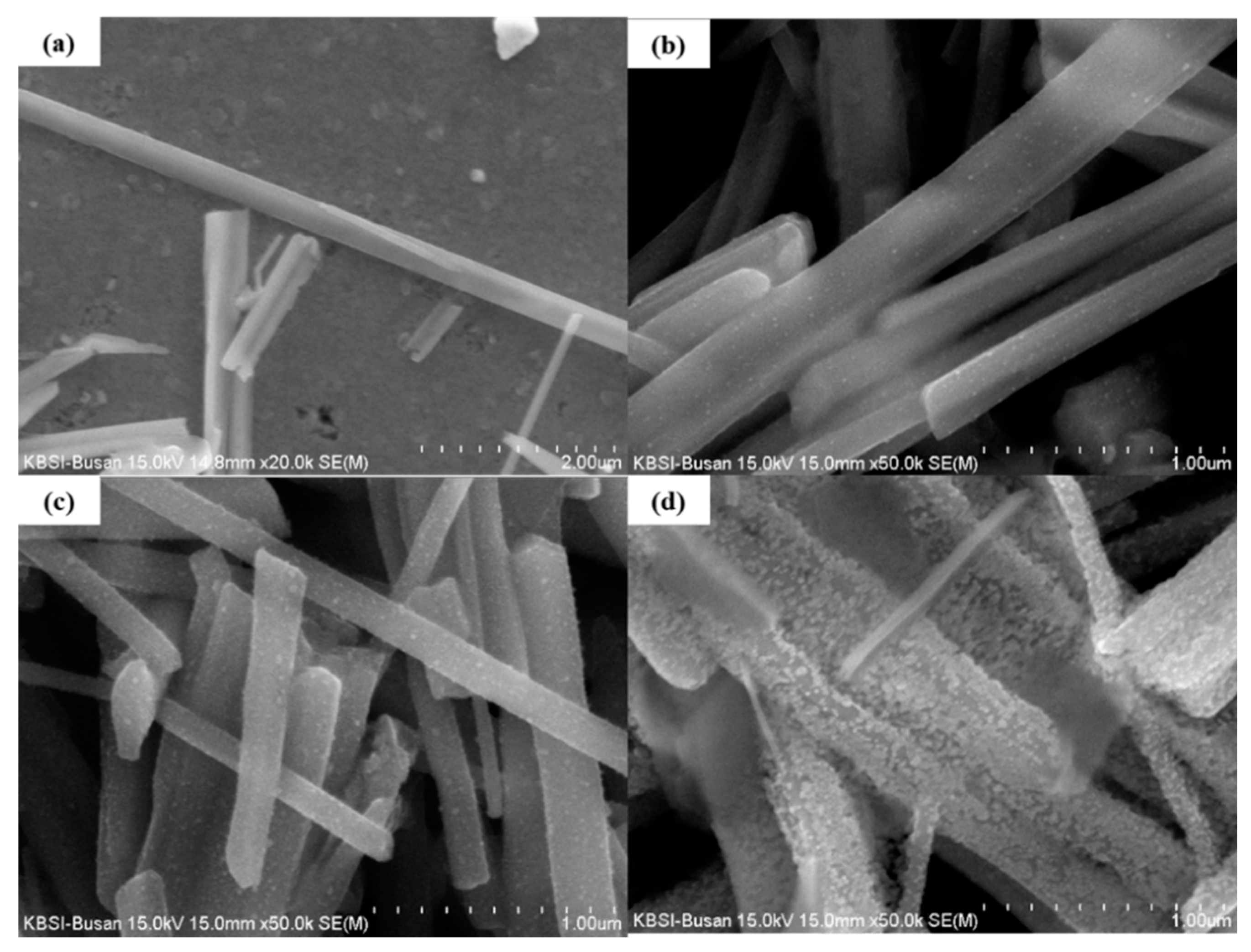
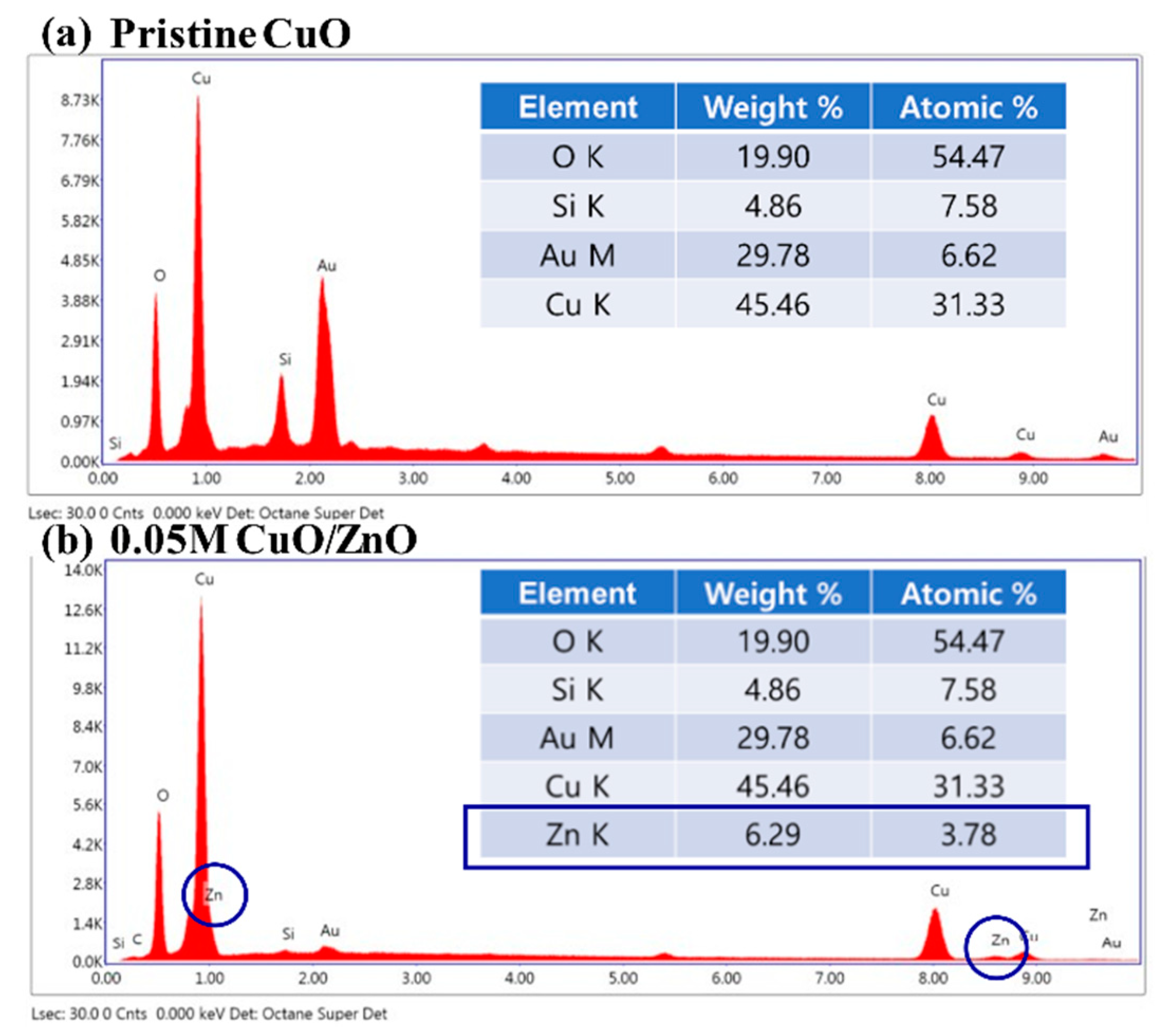



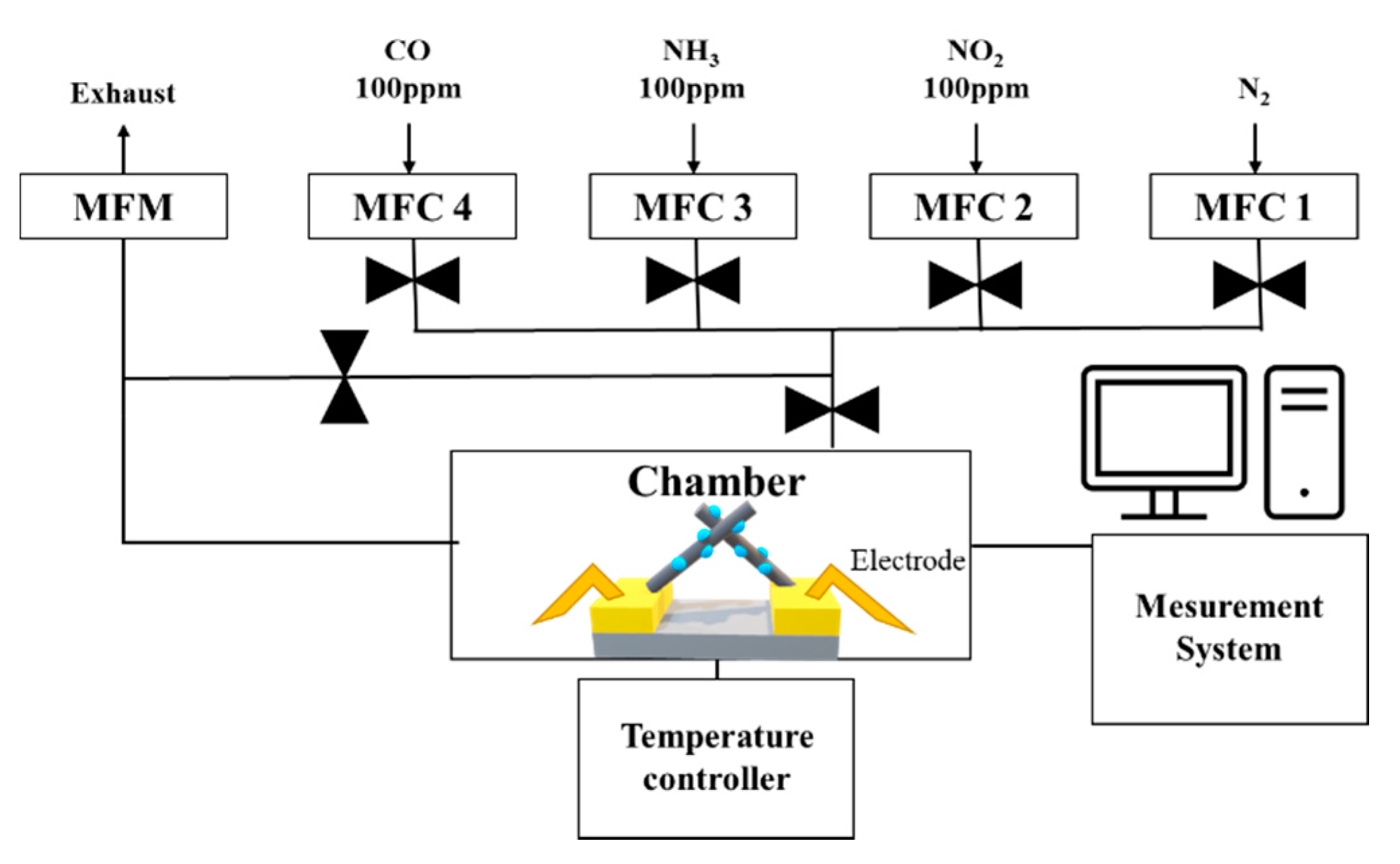
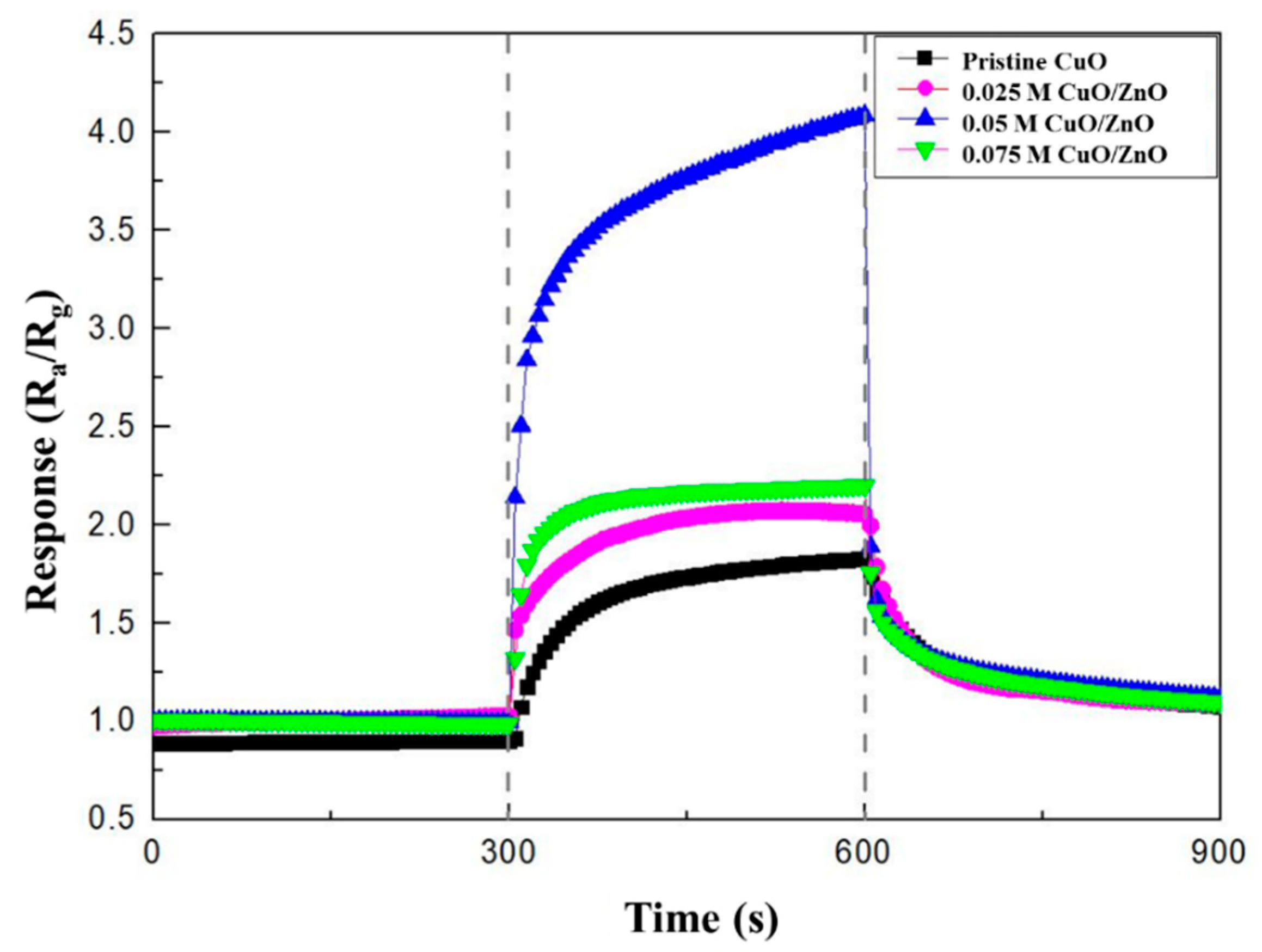
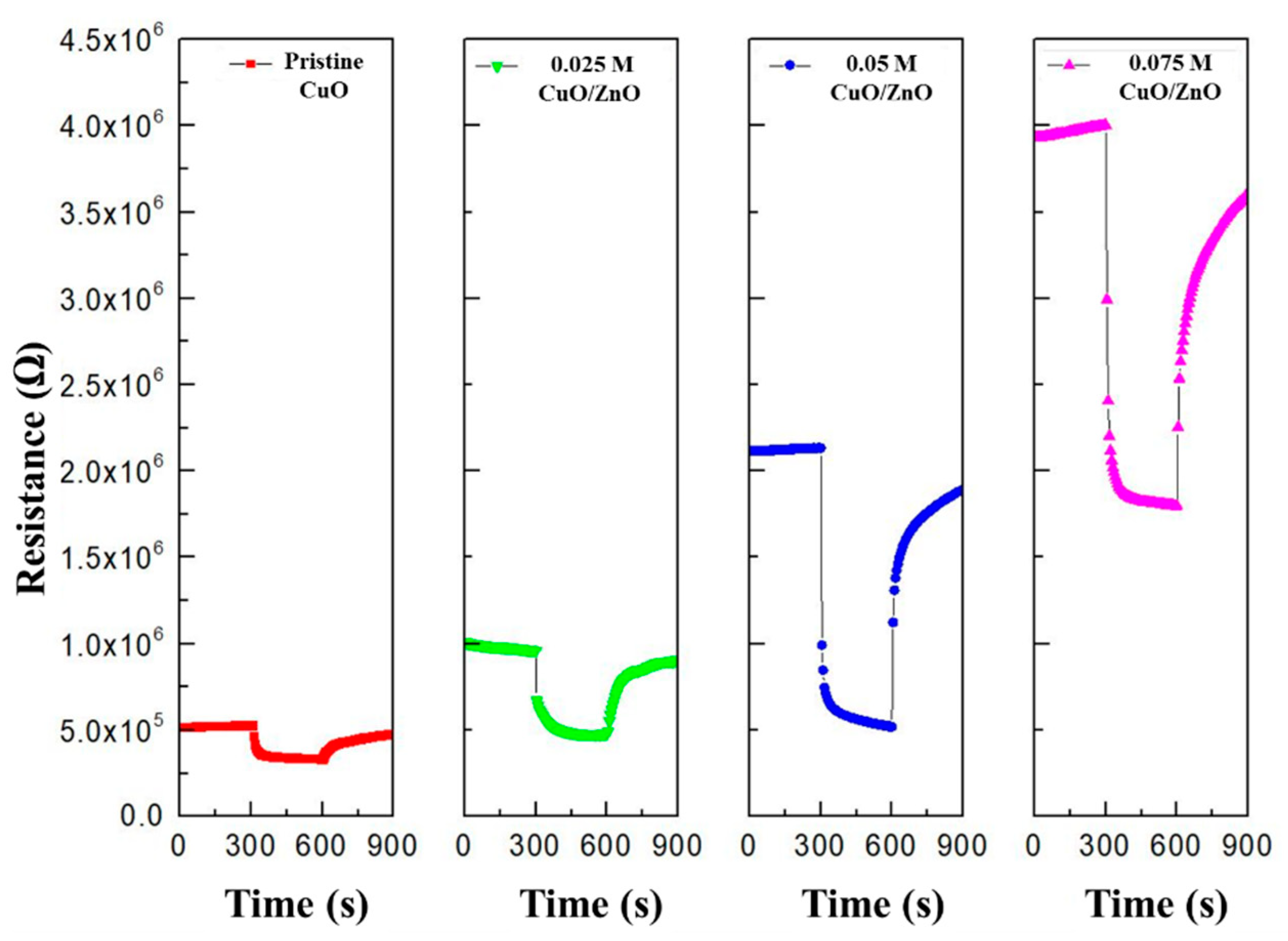
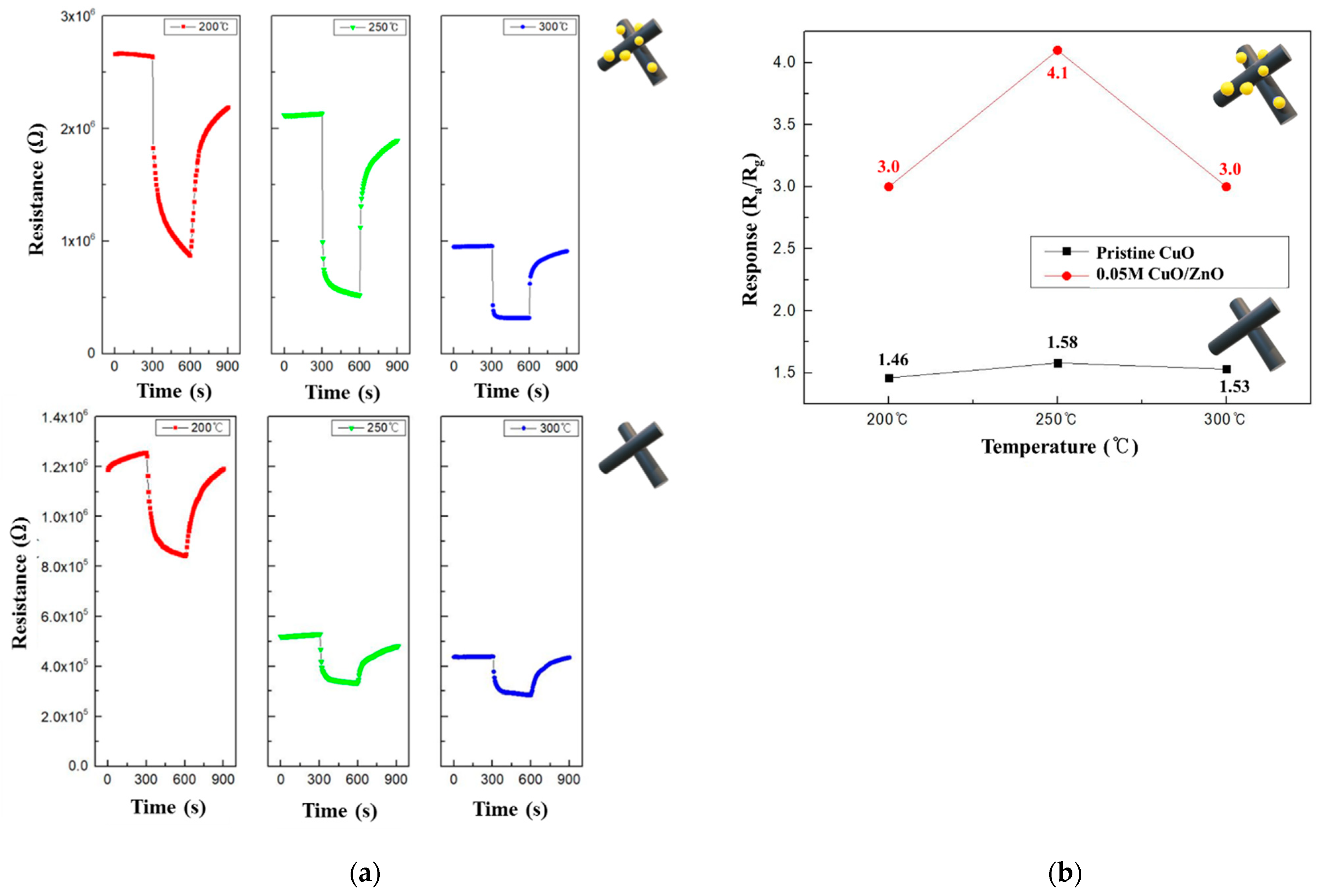

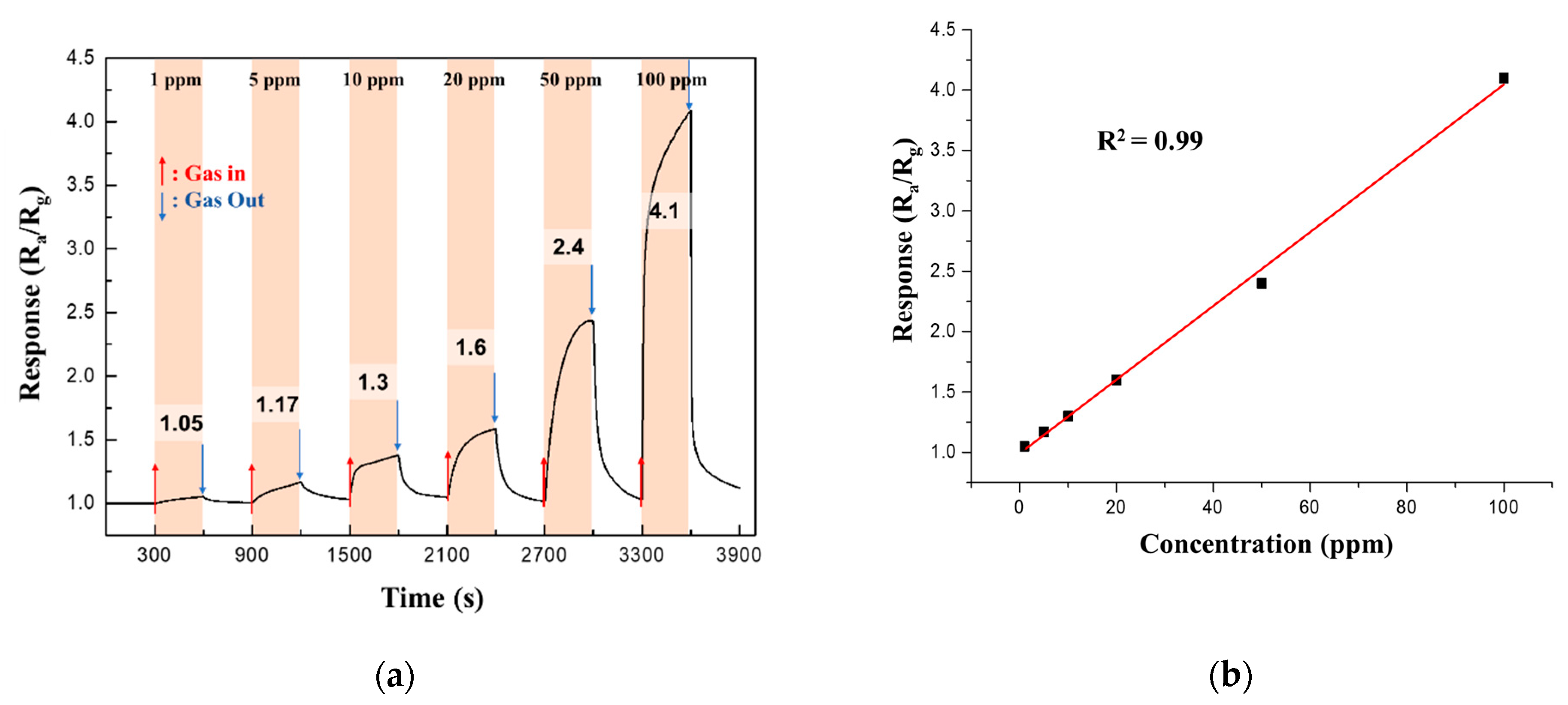
| Pristine CuO | 0.025 M CuO/ZnO | 0.05 M CuO/ZnO | 0.075 M CuO/ZnO | |
|---|---|---|---|---|
| Zn K Weight % (wt.%) | - | 1.17 | 6.29 | 8.66 |
| Zn K Atomic % (at%) | - | 0.75 | 3.78 | 5.66 |
| Sample | Response (Ra/Rg) | Response Time(s) | Recovery Time(s) |
|---|---|---|---|
| Pristine CuO | 1.58 | 60 | 225 |
| 0.025 M CuO/ZnO | 2.0 | 65 | 180 |
| 0.05 M CuO/ZnO | 4.1 | 25 | 150 |
| 0.075 M CuO/ZnO | 2.22 | 20 | 180 |
| Pristine CuO | 0.05 M CuO/ZnO | |
|---|---|---|
| NO2 | 1.58 | 4.1 |
| NH3 | 1.21 | 1.28 |
| CO | 1.19 | 1.18 |
| Material | Structure | Method | Target Gas, Concentration (ppm) | Operating Temperature (°C) | Gas Response | Ref. |
|---|---|---|---|---|---|---|
| CuO | particles | Thermal decomposition | NO2, 100 | 200 | 1.5 | [36] |
| CuO | nanowires | Thermal oxidation | NO2, 4 | 370 | 1.18 | [37] |
| CuO | nanocubes | Polyol process | NO2, 3 | 300 | 0.4 | [38] |
| CuO@ZnO | Core-shell | Two-step solution route | C2H5OH, 50 | 240 | 3.6 | [39] |
| CuO-ZnO | Nanocomposites | Chemical method | NO2, 100 | 200 | 73 % | [29] |
| CuO/ZnO | nanowires | Thermal oxidation | NO2, 100 | 250 | 4.1 | This work |
Publisher’s Note: MDPI stays neutral with regard to jurisdictional claims in published maps and institutional affiliations. |
© 2021 by the authors. Licensee MDPI, Basel, Switzerland. This article is an open access article distributed under the terms and conditions of the Creative Commons Attribution (CC BY) license (http://creativecommons.org/licenses/by/4.0/).
Share and Cite
Han, T.-H.; Bak, S.-Y.; Kim, S.; Lee, S.H.; Han, Y.-J.; Yi, M. Decoration of CuO NWs Gas Sensor with ZnO NPs for Improving NO2 Sensing Characteristics. Sensors 2021, 21, 2103. https://doi.org/10.3390/s21062103
Han T-H, Bak S-Y, Kim S, Lee SH, Han Y-J, Yi M. Decoration of CuO NWs Gas Sensor with ZnO NPs for Improving NO2 Sensing Characteristics. Sensors. 2021; 21(6):2103. https://doi.org/10.3390/s21062103
Chicago/Turabian StyleHan, Tae-Hee, So-Young Bak, Sangwoo Kim, Se Hyeong Lee, Ye-Ji Han, and Moonsuk Yi. 2021. "Decoration of CuO NWs Gas Sensor with ZnO NPs for Improving NO2 Sensing Characteristics" Sensors 21, no. 6: 2103. https://doi.org/10.3390/s21062103
APA StyleHan, T.-H., Bak, S.-Y., Kim, S., Lee, S. H., Han, Y.-J., & Yi, M. (2021). Decoration of CuO NWs Gas Sensor with ZnO NPs for Improving NO2 Sensing Characteristics. Sensors, 21(6), 2103. https://doi.org/10.3390/s21062103






